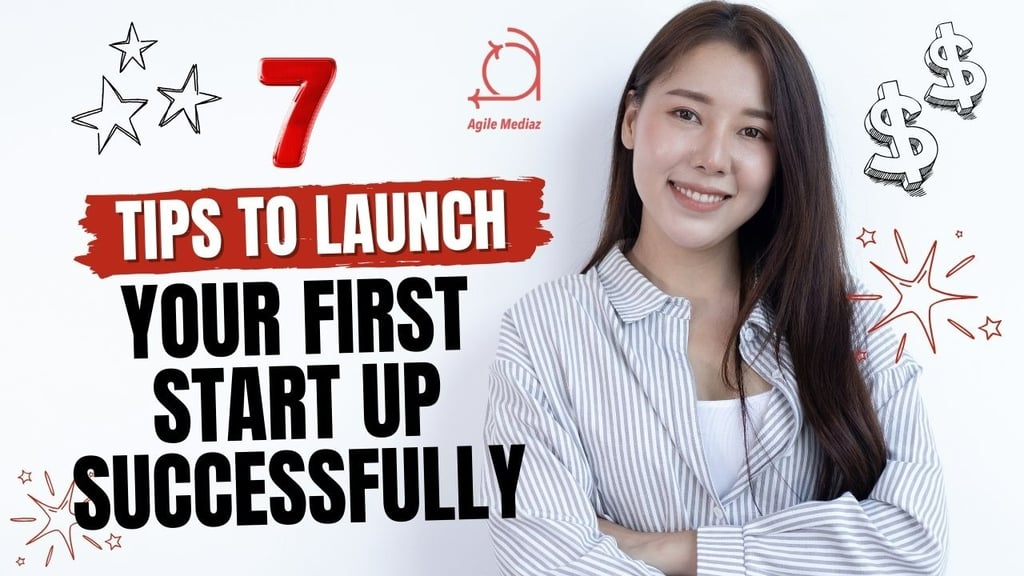7 Tips to Launch Your First Startup Successfully
A practical guide for first-time entrepreneurs to successfully launch their startups with actionable tips on validation, branding, networking, and growth.
ENTREPRENEURSHIPSTRATEGYESSENTIAL TIPSDIGITAL MARKETINGBRAND CREDIBILITYDIGITAL MARKETING TIPS
Agile Mediaz
1/5/20255 min read


Launching your first startup is an exhilarating process, but it can also feel overwhelming. From developing your idea to bringing it to life, there’s a lot to juggle. The key to a successful launch lies in building a solid foundation and staying focused on what matters most. Here are seven actionable tips to help you navigate this journey and position your startup for success.
1. Define Your Unique Selling Proposition (USP)
Your unique selling proposition (USP) is the cornerstone of your startup. It’s what sets you apart from competitors and tells your customers why they should choose you. A well-defined USP not only helps you stand out but also gives your marketing efforts a clear direction.
A strong USP requires you to know your audience and understand the gaps in the market. Ask yourself: What problem does my product or service solve, and how is it better or different than what’s already available? Your USP should address the most pressing needs of your target customers and highlight the unique value your business delivers.
How to Craft Your USP:
Identify your target audience’s biggest pain points.
Focus on your product’s most distinctive features or benefits.
Communicate your USP in simple, clear language that resonates with your audience.
For example, instead of being a generic “meal delivery service,” position yourself as “a meal delivery service that provides fresh, locally sourced meals in under 30 minutes.” The clearer and more specific your USP, the easier it will be to attract the right customers.
Subscribe to our newsletter for more actionable tips and insights!
2. Validate Your Idea with Surveys or Focus Groups
Having a great idea is exciting, but it’s crucial to test its viability before committing significant resources. Validation ensures that your product or service resonates with real people and solves a problem they’re willing to pay to fix.
Conducting market research allows you to gather direct feedback from your target audience. This can save you from investing time and money into a product that might not have demand. It’s better to tweak or pivot your idea early on based on data than to launch something that falls flat.
How to Validate Your Idea:
Use tools like Google Forms or SurveyMonkey to create surveys asking potential customers about their needs and preferences.
Host small focus groups to observe reactions to your concept and gather qualitative insights.
Create a basic landing page or mock-up describing your product and run targeted ads to measure interest (e.g., clicks or email sign-ups).
By validating your idea, you ensure that you’re solving a real problem and that there’s a market ready to embrace your solution.
3. Start Small and Scale with a Minimum Viable Product (MVP)
Perfectionism can be a startup killer. Many first-time entrepreneurs delay their launch because they want their product to have every feature imaginable. However, trying to do everything at once can waste time and money. Instead, focus on creating a minimum viable product (MVP) to get your business off the ground.
An MVP is the simplest version of your product that delivers value to customers. It allows you to launch quickly, test your idea in the real world, and gather feedback to guide further development.
Why an MVP Matters:
It reduces development time and cost.
It allows you to gather real user feedback early on.
It helps you test whether your solution truly solves the problem it’s designed for.
For example, if you’re building a fitness app, your MVP could focus on offering a single workout plan with basic tracking features. Once you’ve validated demand and received user feedback, you can add advanced features like personalized plans or social sharing.
4. Use Free Tools for Branding and Marketing
Creating a professional brand and marketing your startup doesn’t have to cost a fortune. Thanks to a variety of free and low-cost tools, you can establish a polished online presence and start spreading the word about your business without breaking the bank.
These tools allow you to handle many branding and marketing tasks yourself, from designing visuals to managing customer outreach. Starting lean with free resources means you can allocate your budget toward other critical areas of your startup.
Recommended Free Tools:
Canva: Design social media posts, logos, and presentations.
MailerLite: Build email marketing campaigns to connect with your audience.
Google Analytics: Track website traffic and understand user behavior.
HubSpot CRM: Manage customer relationships and track sales leads.
Using these tools effectively helps you look professional while saving money—an essential strategy when launching your startup on a budget.
5. Focus on Building a Strong Personal Brand on LinkedIn
As the founder of a startup, your personal brand can play a huge role in attracting clients, investors, and even collaborators. LinkedIn is a powerful platform for building credibility and connecting with the people who can help your business grow.
Think of LinkedIn as your personal pitch deck. Your profile and activity should reflect your expertise, enthusiasm, and vision. Potential investors or clients often research founders online, and a strong LinkedIn presence can leave a lasting impression.
How to Build Your Personal Brand:
Optimize your profile with a professional photo, clear headline, and detailed “About” section.
Share valuable insights about your industry, tips, or personal lessons.
Engage with relevant posts in your network and participate in industry discussions.
Use the "Featured" section to showcase milestones, case studies, or articles about your startup.
The connections you build on LinkedIn can open doors to new opportunities and partnerships that accelerate your startup’s success.
6. Network with Other Entrepreneurs Through Online Communities
Building a startup can feel isolating at times, but you don’t have to go it alone. Networking with fellow entrepreneurs not only provides support and advice but also exposes you to valuable opportunities for collaboration or mentorship.
Online communities are particularly useful for first-time founders. They allow you to share experiences, learn from others, and stay motivated by connecting with like-minded individuals.
Where to Network Online:
Facebook Groups like “Startup Hustle” or “Entrepreneurs Helping Entrepreneurs.”
LinkedIn Groups focused on your industry or niche.
Forums like Indie Hackers or Reddit’s r/startups for sharing ideas and tips.
By actively engaging in these communities, you can build relationships that offer insights, partnerships, and encouragement during your entrepreneurial journey.
7. Track and Adjust Based on Analytics from the Start
One of the biggest advantages of launching a startup today is the abundance of data available to guide your decisions. Tracking analytics from day one ensures that you can measure your progress, identify areas for improvement, and pivot when necessary.
What to Track:
Website Traffic: Use Google Analytics to monitor where visitors come from and which pages they visit.
Conversion Rates: Measure how many visitors take desired actions, such as signing up for emails or making purchases.
Social Media Metrics: Track engagement (likes, shares, comments) to see which content resonates with your audience.
Data-driven decision-making is key to refining your business strategy. Regularly analyze your performance and adjust your efforts to ensure long-term growth.
Final Thoughts: Plan, Execute, and Adapt
Launching your first startup is a challenging but rewarding journey. By defining your USP, validating your idea, starting small with an MVP, and leveraging free tools and data, you can build a strong foundation for success. Remember to stay flexible, learn from feedback, and adapt to new challenges as they arise.
Connect
Empowering small businesses through digital marketing solutions.
Explore
Innovate
contact@agilemediaz.net
© 2024. All rights reserved.

